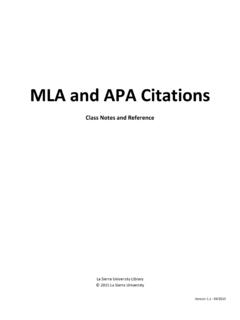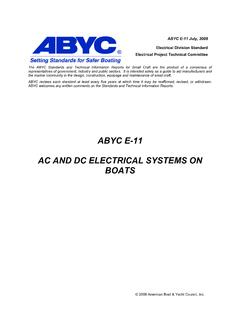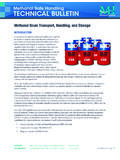Transcription of Safety Data Sheet Gasoline, Unleaded Sample
1 Safety Data Sheet gasoline , Unleaded Sample Please note: the following is not intended to represent factual information for this product. It is to be used during training as an example of what a new Safety data Sheet will look like under the new Hazard Communication Standard requirements. As you are reading through this document you will notice 16 sections shaded in blue. These are the new required 16 sections that you will see on all Safety Data Sheets once the new standard rules are applied. Any section shaded in yellow is additional information that would not be seen on a normal SDS. If there is no yellow area included under a section it is because we feel that area is self explanatory. Section 1: Identification In this section you will find the product name which will be listed on the label as well as any contact information on the manufacturer. Product name : gasoline , Unleaded Synonyms : Blend of Highly Flammable Petroleum Distillates, Regular, Mid-Grade, Premium, 888100008809 SDS Number : 888100008809 Version : Product Use Description : Fuel Company : Big Joe s Oil Corp.
2 555 Oil Lane, Lubbock, TX 77777 Big Joe s Call Center : (877) 783-7676 Chemtrec : (800) 424-9300 (Emergency Contact) Section 2: Hazard(s) Identification When looking at the different classifications of hazards this chemical meets you will see category numbers to tell you how severe the hazard is. Please remember, these numbers ARE NOT the same as the old NFPA / HMIS system. In this case, the numbering generally starts at 1(most hazardous) and ends at 5(Least hazardous). There are letters used in certain categories as well. Always remember, the lower the number or letter, the more severe the hazard. Classifications : Flammable Liquid Category 1 Aspiration Hazard Category 1 Carcinogenicity Category 2 Specific Target Organ Toxicity (Repeated Exposure) Category 2 Specific Target Organ Toxicity (Single Exposure) Category 3 Skin Irritation Category 2 Eye Irritation Category 2B Chronic Aquatic Toxicity Category 2 Pictograms : Signal Word: Danger Hazard Statements: Extremely flammable liquid and vapor.
3 May be fatal if swallowed and enters airways do not siphon gasoline by mouth. Suspected of causing blood cancer if repeated over-exposure by inhalation and/or skin contact occurs. May cause damage to liver, kidneys and nervous system by repeated and prolonged inhalation or skin contact. Causes eye irritation. Can be absorbed through skin. May cause drowsiness or dizziness. Extreme exposure such as intentional inhalation may cause unconsciousness, asphyxiation and death. Repeated or prolonged skin contact can cause irritation and dermatitis. Harmful to aquatic life. Precautionary statements Prevention : Obtain special instructions before use. Do not handle until all Safety precautions have been read and understood. Keep away from heat, sparks, open flames, welding and hot surfaces. No smoking. Keep container tightly closed. Ground and/or bond container and receiving equipment. Use explosion-proof electrical equipment.
4 Use only non-sparking tools (if tools are used in flammable atmosphere). Take precautionary measures against static discharge . Wear gloves, eye protection and face protection (as needed to prevent skin and eye contact with liquid). Wash hands or liquid-contacted skin thoroughly after handling. Do not eat, drink or smoke when using this product. Do not breathe vapors. Use only outdoors or in a well-ventilated area. Response : In case of fire: Use dry chemical, CO2, water spray or fire fighting foam to extinguish. If swallowed: Immediately call a poison center, doctor, hospital emergency room, medical clinic or 911. Do NOT induce vomiting. Rinse mouth. If on skin (or hair): Take off immediately all contaminated clothing. Rinse skin with water/shower. If in eye: Rinse cautiously with water for several minutes. Remove contact lenses, if present and easy to do. Continue rinsing. If skin or eye irritation persists, get medical attention.
5 If inhaled: Remove person to fresh air and keep comfortable for breathing. Get medical attention if you feel unwell. Storage : Store in a well ventilated place. Keep cool. Store locked up. Keep container tightly closed . Use only approved containers. Some containers not approved for gasoline may dissolve and release flammable gasoline liquid and vapors. Disposal : Dispose of contents/containers to approved disposal site in accordance with local, regional, national, and/or international regulations. Section 3: Composition/Information on Ingredients This section lists the ingredients of this chemical. For Exposure limits please refer to section 8 of this document. Component CAS-No. Weight % gasoline , natural; Low boiling point naphtha 8006-61-9 10 -30% Toluene 108-88-3 10 -30% Xylene 1330-20-7 10 -30% Ethanol; ethyl alcohol 64-17-5 Trimethylbenzene 25551-13-7 1 -5% Isopentane; 2-methylbutane 78-78-4 1 -5% Naphthalene 91-20-3 1 -5% Benzene 71-43-2 Less than Pentane 109-66-0 1 -5% Cyclohexane 110-82-7 1 -5% Ethylbenzene 100-41-4 1 -5% Butane 106-97-8 1 -20% Heptane [and isomers] 142-82-5 N-hexane 110-54-3 Section 4: First-Aid Measures This area will tell you what to do if there is an exposure to this chemical.
6 If there is an exposure situation that requires emergency care, remember to bring a copy of this document as there are specific physician notes listed. Inhalation: If inhaled, remove to fresh air. If not breathing, give artificial respiration. If breathing is difficult, give oxygen. Seek medical attention immediately. Skin contact : In case of contact, immediately flush skin with plenty of water. Take off contaminated clothing and shoes immediately. Wash contaminated clothing before re-use. Contaminated leather, particularly footwear, must be discarded. Note that contaminated clothing may be a fire hazard. Seek medical advice if symptoms persist or develop. Eye contact : Remove contact lenses. Rinse immediately with plenty of water, also under the eyelids, for at least 15 minutes. Seek medical advice if symptoms persist or develop. Ingestion : Do NOT induce vomiting. Never give anything by mouth to an unconscious person.
7 Obtain medical attention. Notes to physician : Symptoms: Dizziness, Discomfort, Headache, Nausea, Kidney disorders, Liver disorders. Aspiration may cause pulmonary edema and pneumonitis. Swallowing gasoline is more likely to be fatal for small children than adults, even if aspiration does not occur. Section 5: Fire-Fighting Measures This section lists how to extinguish a fire but more importantly any specific hazards that can be created should this product burn. Suitable extinguishing media : SMALL FIRES: Any extinguisher suitable for Class B fires, dry chemical, CO2, water spray or fire fighting foam. LARGE FIRES: Water spray, fog or fire fighting foam. Water may be ineffective for fighting the fire, but may be used to cool fire exposed containers. Keep containers and surroundings cool with water spray. Specific hazards during fire fighting: Extremely flammable liquid and vapor. This material is combustible/flammable and is sensitive to fire, heat, and static discharge .
8 Special protective equipment for fire-fighters : Firefighting activities that may result in potential exposure to high heat, smoke ortoxic by-products of combustion should require NIOSH/MSHA- approved pressure-demand self-contained breathing apparatus with full face-piece and full protective clothing. Further information : Isolate area around container involved in fire. Cool tanks, shells, and containers exposed to fire and excessive heat with water. For massive fires the use of unmanned hose holders or monitor nozzles may be advantageous to further minimize personnel exposure. Major fires may require withdrawal, allowing the tank to burn. Large storage tank fires typically require specially trained personnel and equipment to extinguish the fire, often including the need for properly applied fire fighting foam. Exposure to decomposition products may be a hazard to health. Use extinguishing measures that are appropriate to local circumstances and the surrounding environment.
9 Use water spray to cool unopened containers. Fire residues and contaminated fire extinguishing water must be disposed of in accordance with local regulations. Section 6: Accidental Release Measures Personal precautions : Evacuate personnel to safe areas. Ventilate the area. Remove all sources of ignition. Response and clean-up crews must be properly trained and must utilize proper protective equipment (see Section 8). Environmental precautions : discharge into the environment must be avoided. If the product contaminates rivers and lakes or drains inform respective authorities. Methods for cleaning up : Contain and collect spillage with non-combustible absorbent material, ( sand, earth, diatomaceous earth, vermiculite) and place in container for disposal according to local / national regulations. Section 7: Handling and Storage Critical information on how this chemical will react to certain physical conditions will be listed here as well as safe storage conditions.
10 Precautions for safe handling : Keep away from fire, sparks and heated surfaces. No smoking near areas where material is stored or handled. The product should only be stored and handled in areas with intrinsically safe electrical classification. Hydrocarbon liquids including this product can act as a non-conductive flammable liquid (or static accumulators), and may form ignitable vapor-air mixtures in storage tanks or other containers. Precautions to prevent static-initiated fire or explosion during transfer, storage or handling, include but are not limited to these examples: (1) Ground and bond containers during product transfers. Grounding and bonding may not be adequate protection to prevent ignition or explosion of hydrocarbon liquids and vapors that are static accumulators. (2) Special slow load procedures for "switch loading" must be followed to avoid the static ignition hazard that can exist when higher flash point material (such as fuel oil or diesel) is loaded into tanks previously containing low flash point products (such gasoline or naphtha).








